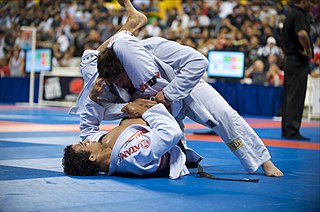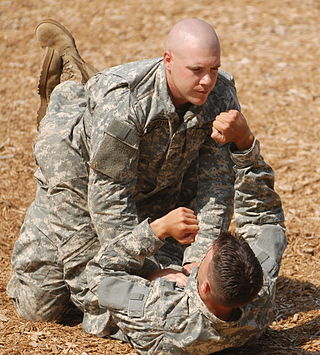
Pankration was an unarmed combat sport introduced into the Greek Olympic Games in 648 BC. The athletes used boxing and wrestling techniques but also others, such as kicking, holds, joint-locks, and chokes on the ground, making it similar to modern mixed martial arts. The term comes from the Greek παγκράτιον, meaning 'all of power', from πᾶν (pan) 'all' and κράτος (kratos) 'strength, might, power'.

Brazilian jiu-jitsu is a self-defence martial art and combat sport based on grappling, ground fighting, and submission holds. BJJ focuses on taking ones opponent down to the ground, gaining a dominant position, and using a number of techniques to force them into submission via joint locks or chokeholds.
Professional wrestling holds include a number of set moves and pins used by performers to immobilize their opponents or lead to a submission. This article covers the various pins, stretches and transition holds used in the ring. Some wrestlers use these holds as their finishing maneuvers, often nicknaming them to reflect their character or persona. Moves are listed under general categories whenever possible.

The guard is a ground grappling position in which one combatant has their back to the ground while attempting to control the other combatant using their legs. In pure grappling combat sports, the guard is considered an advantageous position, because the bottom combatant can attack with various joint locks and chokeholds, while the top combatant's priority is the transition into a more dominant position, a process known as passing the guard. In the sport of mixed martial arts, as well as hand-to-hand combat in general, it is possible to effectively strike from the top in the guard, even though the bottom combatant exerts some control. There are various types of guard, with their own advantages and disadvantages.

A chokehold, choke, stranglehold or, in Judo, shime-waza is a general term for a grappling hold that critically reduces or prevents either air (choking) or blood (strangling) from passing through the neck of an opponent. The restriction may be of one or both and depends on the hold used and the reaction of the victim. While the time it takes for the choke to render an opponent unconscious varies depending on the type of choke, the average across all has been recorded as 9 seconds.

The guillotine choke, also known as Mae Hadaka Jime in judo, is a chokehold in martial arts applied from in front of the opponent, often on the ground but can also be done while standing. The choke involves using the arms to encircle the opponent's neck that bears a resemblance to the blade of a guillotine.
A triangle choke, or sankaku-jime (三角絞) in judo, is a type of figure-four chokehold that encircles the opponent's neck and one arm with the legs in a configuration similar to the shape of a triangle. Applying pressure using both legs and the opponent's own shoulder, the technique is a type of lateral vascular restraint that constricts the blood flow from the carotid arteries to the brain, potentially resulting in loss of consciousness in seconds when applied correctly. Recent studies have shown that the triangle choke takes an average of 9.5 seconds to render an opponent unconscious from the moment it is properly applied.
An armlock in grappling is a single or double joint lock that hyperextends, hyperflexes or hyperrotates the elbow joint or shoulder joint. An armlock that hyper-extends the elbow is known as an armbar, and it includes the traditional armbar, the shoulder triangle armbar, and the shotgun armbar. An armlock that hyper-rotates the arm is known as an armcoil, and includes the americana, kimura, and omaplata. Depending on the joint flexibility of a person, armcoils can either hyper-rotate only the shoulder joint, only the elbow joint, or both the elbow joint and shoulder joint.

A grappling hold, commonly referred to simply as a hold that in Japanese is referred to as katame-waza, is any specific grappling, wrestling, judo, or other martial art grip that is applied to an opponent. Grappling holds are used principally to control the opponent and to advance in points or positioning. The holds may be categorized by their function, such as clinching, pinning, or submission, while others can be classified by their anatomical effect: chokehold, headlock, joint-lock, or compression lock. Multiple categories may be appropriate for some of these holds.

In combat sports, the north–south position is a ground grappling position where one combatant is supine, with the other combatant invertedly lying prone on top, normally with their head over the bottom combatant's chest. The north–south position is a dominant position, where the top combatant can apply effective strikes such as knee strikes to the head, or easily transition into various grappling holds or more dominant positions. Transitioning into side control can be done by first switching into a particular hold known as ushiro-kesa-gatame (後袈裟固) or reverse scarf hold, where the chest points to the side, and the opponent's arm is controlled similarly to kesa-gatame. The north–south choke is employed exclusively from this position.

A compression lock, muscle lock, muscle slicer or muscle crusher, is a grappling hold that causes severe pain by pressing a muscle into a bone. A compression lock can cause a joint lock in a nearby joint when it is applied by squeezing a limb over a fulcrum. A forceful compression lock may damage muscles and tendons, and if accompanied by a joint lock, may also result in torn ligaments, dislocation or bone fractures. Compression locks can be used as pain compliance holds, and are sometimes featured in combat sports as submission holds.

Kata-Gatame (肩固) is one of the seven mat holds, Osaekomi-waza, of Kodokan Judo. It is also one of the 25 techniques of Danzan Ryu's constriction arts, Shimete, list. In grappling terms, it is categorized as a side control hold. Primarily used as a hold down in Judo, it is mostly used as a choke in Jiu-Jitsu and mixed martial arts. WWE wrestler Braun Strowman and former Impact Wrestling Superstar, Samuel Shaw use this move as their finishing maneuver.

Nami Jūji-jime (並十字絞) is one of the twelve constriction techniques of Kodokan Judo in the Shime-waza list. Also known as Namijujijime, Danzan Ryu includes this technique in the Shimete list under the name Gyakujujijime.
Gyaku Jūji-jime (逆十字絞), or gyakujujijime, is a chokehold in judo. It is one of the twelve constriction techniques of Kodokan Judo in the Shime-waza list. Danzan Ryu includes this technique in the Shimete list under the name Namijujijime. Ura-Juji-Jime is described in the Canon Of Judo and demonstrated in The Essence of Judo by Kyuzo Mifune.

Yoseikan Aikido is the aikido taught at the Yoseikan Dojo in Shizuoka, Japan, under the direction of Minoru Mochizuki.

A gogoplata, foot choke "Piroplata" or kagato-jime (踵絞) is a type of chokehold that utilizes the shin bone. This technique is often used in Kodokan Judo, submission grappling, and Brazilian jiu-jitsu.

Jujutsu, also known as jiu-jitsu and ju-jitsu, is a family of Japanese martial arts and a system of close combat that can be used in a defensive or offensive manner to kill or subdue one or more weaponless or armed and armored opponents. It was designed in the 1530s and is coined by Hisamori Tenenuchi when he officially established the first school of Jiu-Jitsu in Japan. A subset of techniques from certain styles of jujutsu were used to develop many modern martial arts and combat sports, such as judo, aikido, sambo, ARB, Brazilian jiu-jitsu, and mixed martial arts.


















